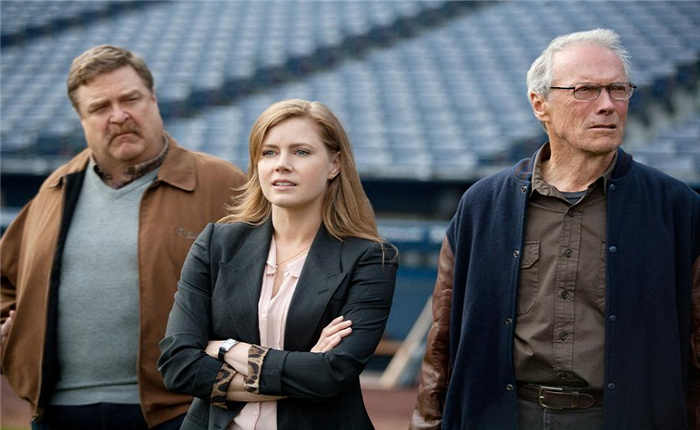It’s been mere weeks since Clint Eastwood delivered his empty-chair monologue at the Republic National Convention, and audiences will have a hard time shaking it from their memory as they watch “Trouble with the Curve.” Eastwood plays aging baseball scout Gus Lobel, a more doddering and less racist version of the misanthropic retiree he played in “Gran Torino,” and the film’s opening scenes present him as a man ravaged by weakness and senility, the qualities that seemed disturbingly present in his already infamous speech.
Yet as “Trouble with the Curve” progresses, Eastwood makes clear that he’s just acting, and that there’s still a great deal of life left in Mr. Eastwood himself. If only the same could be said for the movie. Despite its star’s commendable performance, the film is a curiously mawkish piece of work, one that willfully ignores the darkness bubbling beneath its maudlin surface.

The plot centers on Gus’s attempts to scout a high school player in North Carolina. Unfortunately, a pompous co-worker (Matthew Lillard) is urging Gus’s boss to replace him with a computer program, and glaucoma is wreaking havoc with the elderly man’s eyesight. The latter dilemma means that Lobel’s estranged daughter, Mickey (Amy Adams), is obliged to take a leave from her legal career and watch over her dad as he goes on the scouting mission and occasionally socializes with rival scout Johnny Flanagan (Justin Timberlake). None of this is remarkably out of the ordinary for a sports movie, yet the film seems to hint at more troubling issues: senility, mortality, obsolescence. It then proceeds to ignore those issues with an absurdly neat ending, featuring redemption and comeuppance doled out in quantities so exact the film comes to resemble a zero-sum game.
These problems are epitomized by the treatment of Lillard’s character, Tom Silver. As Silver, Lillard is meant to be nothing more than a blowhard, spouting lines like, “It’s all in the computers—you don’t need to see the players.” The film never asks the audience to engage with this philosophy—it just asks them to dismiss it. This is a fatal misstep. Silver represents the possibility of obsolescence for Gus—a possibility that Lorenz and screenwriter Randy Brown urge the audience to shrug off. One wonders what Eastwood himself would have done with the material; though director Robert Lorenz has served as Eastwood’s producer for a number of films in t he past decade, he can’t conjure up the sort of clear-eyed vision that drives a film like Eastwood’s “Mystic River.”
There is another reason to wish that Eastwood hadn’t confined himself to acting in this film: Lorenz, for all his producing credits, proves himself a startlingly uninspired director. The film contains several sequences shot with astonishing clumsiness —crucially, the only scenes that actually involve sports. Nearly every one of these sequences leans heavily on slow-motion, making what should be the most invigorating scenes into overdone dreck. Even the less egregiously directed scenes leave the viewer with little to admire; in a movie filled to the brim with conversations, Lorenz chooses to shoot every one with the same three-quarter shots. In a movie nearly two hours long, this lack of variety grows infuriating quickly.

This technical incompetency is especially frustrating because it obscures the cast’s respective performances, which are largely quite enjoyable. Amy Adams, as a female outsider in a world of male obsessives, turns in a competent variation on her role in “The Muppets.” Lillard and John Goodman, as Gus’s good friend and co-worker, also give fine supporting performances: Goodman, as usual, simply exudes likability, while Lillard, hot off his role as an adulterer in “The Descendants,” seems primed for a career as a consummately slimy character actor. The one real mistake is the casting of Timberlake as Flanagan, a star pitcher turned scout. Though the chemistry between him and Adams is palpable, Timberlake is ultimately far too slick and effete for this role, which demands a more convincingly athletic actor.
Yet these performances can’t rescue what is essentially a half-baked project, one that includes clear hints of darkness seemingly only to ignore them. “Trouble with the Curve” is an aggressively optimistic film that does nothing to merit that optimism; though the main exposition is portray how difficult it is for Gus to survive on a day-to-day basis, the filmmakers ultimately ignore the premise that they’ve set up. These issues are exacerbated by a directorial style that is at best undistinguished and at worse thoroughly inept. It’s a good thing Eastwood still shows signs of life; “Trouble with the Curve” might otherwise be an undeserving end to an iconic career.

Leave a Reply